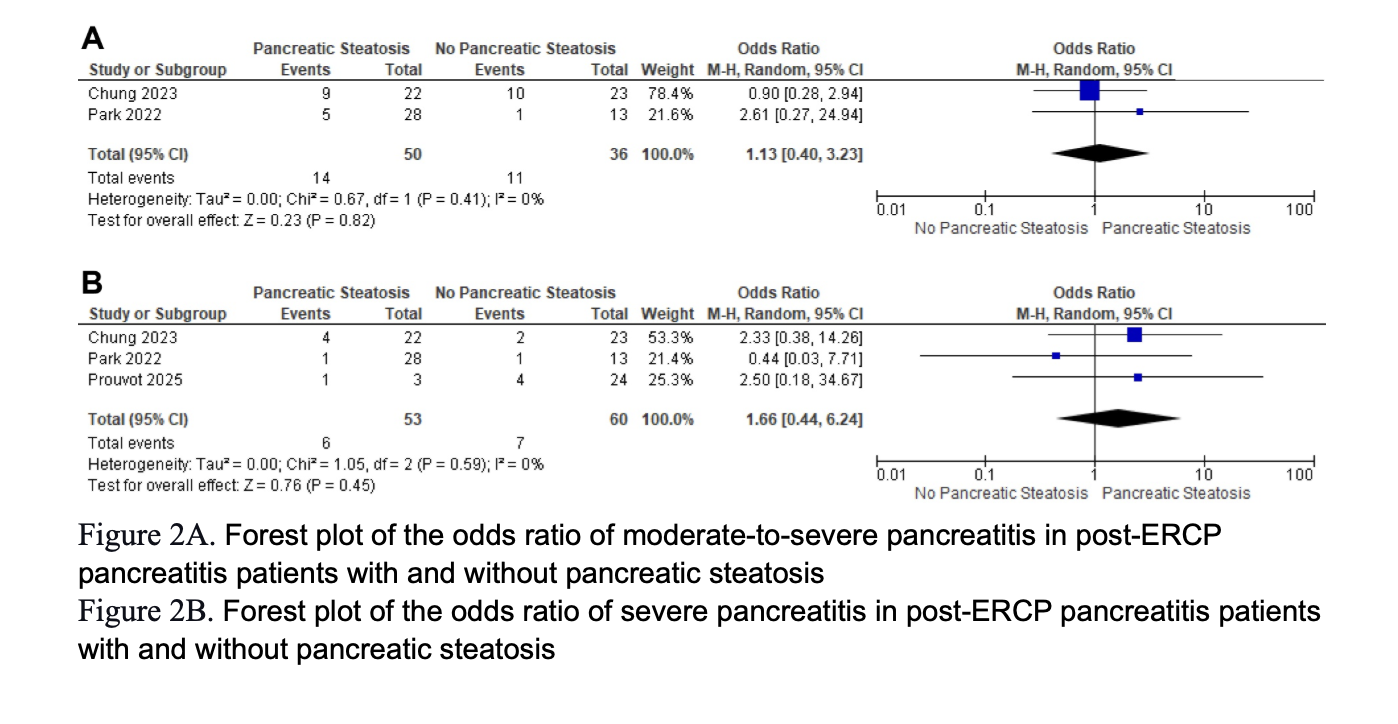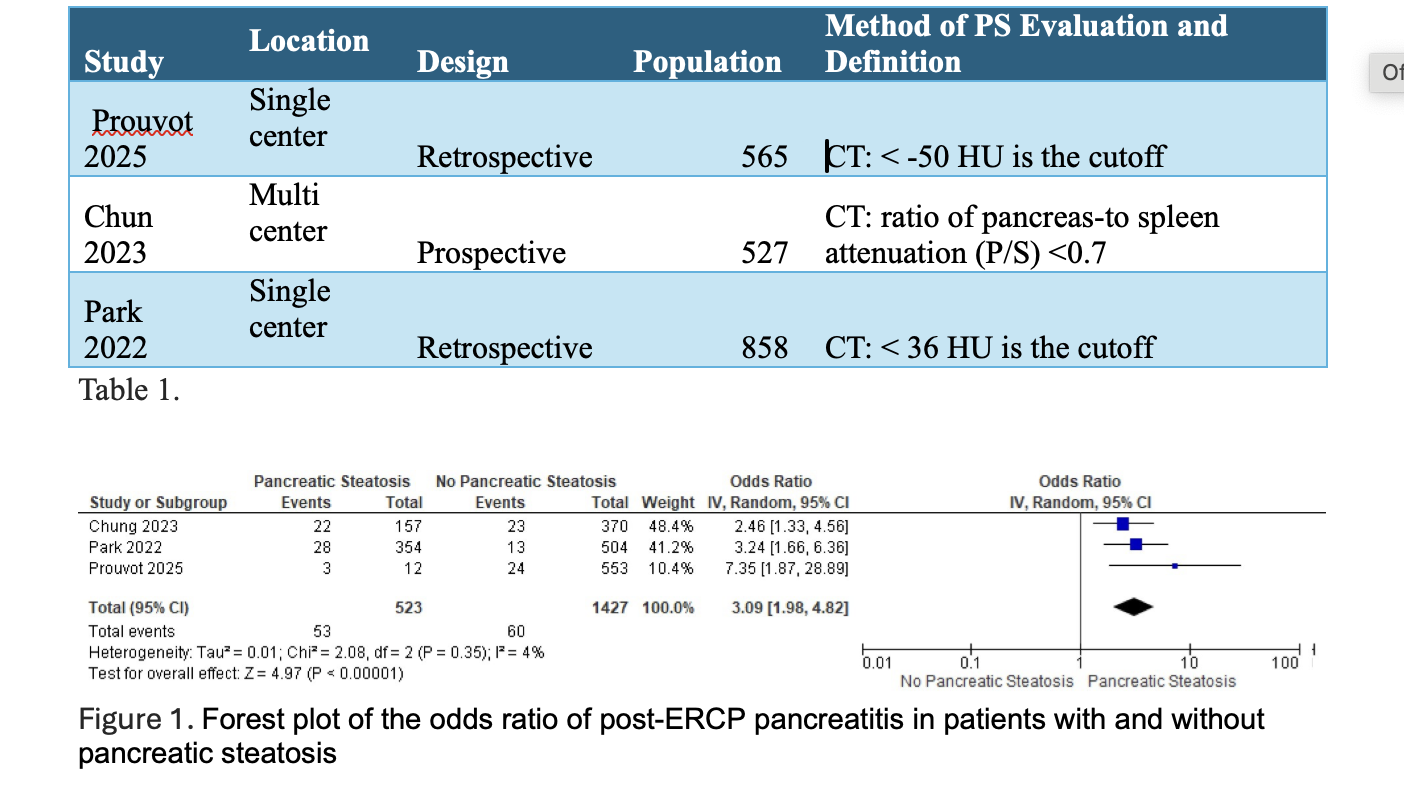Sunday Poster Session
Category: Biliary/Pancreas
P0025 - Does Fat Fuel the Fire? Relationship Between Pancreatic Steatosis and Post-ERCP Pancreatitis: A Systematic Review and Meta-Analysis
Sunday, October 26, 2025
3:30 PM - 7:00 PM PDT
Location: Exhibit Hall

Mohamad Khaled Almujarkesh, MD
AdventHealth
Orlando, FL
Presenting Author(s)
Mohamad Khaled Almujarkesh, MD1, Tareq Alsaleh, MD2, Baha Fawwaz, MD3, John George, MD3, Mustafa Arain, MD4
1AdventHealth, Orlando, FL; 2Department of Internal Medicine, AdventHealth Orlando, Orlando, FL; 3Department of Gastroenterology and Hepatology, AdventHealth Orlando, Orlando, FL; 4Center for Interventional Endoscopy, AdventHealth Orlando, Orlando, FL
Introduction: Post-ERCP pancreatitis (PEP) is one of the most serious adverse effects of endoscopic retrograde cholangiopancreatography (ERCP) due to its high morbidity and mortality. Although several risk factors for PEP have been identified, the role of pancreatic steatosis (PS) remains inadequately explored. Emerging literature suggests a potential relationship with metabolic syndrome as well as an increased risk of acute pancreatitis. There is a gap in understanding its impact on PEP. We thus conducted a systematic review and meta-analysis to investigate the relationship between PS and PEP.
Methods: Online databases, including Embase, Medline (via PubMed), and Scopus, were searched from inception through March 2025. Studies evaluating the incidence of PEP, including severe PEP, following ERCP were included. The outcomes of interest were the incidence and severity of PEP. Standard meta-analysis methods were followed using the random-effects model. Treatment effect estimates were expressed as odds ratio (OR) and 95% confidence interval (CI). Heterogeneity was assessed using the I² statistic.
Results: Our search yielded three studies that met eligibility criteria. They included 1,950 patients. Pancreatic steatosis was present in 523 (26.82%) patients. Study characteristics are summarized in table 1. Pooled analysis showed a significant increase in the odds of PEP in patients with PS (OR 3.09, 95% CI 1.98-4.82, p < 0.001, I² = 4%) (Figure 1). There was also a small trend towards increased odds of moderate-to-severe (OR 1.13, 95% CI 0.40-3.23, p = 0.82, I² = 0%) and severe (OR 1.66, 95% CI 0.44-6.24, p = 0.45, I² = 0%) pancreatitis in PEP patients with PS, but it was not statistically significant (Figure 2).
Discussion: This meta-analysis suggests that PS may be a significant risk factor for the development of PEP. The overall incidence of PEP was higher in PS group. While the association did not achieve statistical significance, a slight upward trend in the severity of post-ERCP pancreatitis (PEP) was noted among patients with pancreatic steatosis (PS). Further high-quality prospective studies are essential to explore pancreatic steatosis which could help to identify high risk patients and implement PEP prevention strategies

Figure: Figure 1. Forest plot of the odds ratio of post-ERCP pancreatitis in patients with and without pancreatic steatosis

Figure: Figure 2A. Forest plot of the odds ratio of moderate-to-severe pancreatitis in post-ERCP pancreatitis patients with and without pancreatic steatosis
Figure 2B. Forest plot of the odds ratio of severe pancreatitis in post-ERCP pancreatitis patients with and without pancreatic steatosis
Disclosures:
Mohamad Khaled Almujarkesh indicated no relevant financial relationships.
Tareq Alsaleh indicated no relevant financial relationships.
Baha Fawwaz indicated no relevant financial relationships.
John George indicated no relevant financial relationships.
Mustafa Arain: Boston Scientific – Consultant. Cook Endoscopy – Consultant. Olympus – Consultant.
Mohamad Khaled Almujarkesh, MD1, Tareq Alsaleh, MD2, Baha Fawwaz, MD3, John George, MD3, Mustafa Arain, MD4. P0025 - Does Fat Fuel the Fire? Relationship Between Pancreatic Steatosis and Post-ERCP Pancreatitis: A Systematic Review and Meta-Analysis, ACG 2025 Annual Scientific Meeting Abstracts. Phoenix, AZ: American College of Gastroenterology.
1AdventHealth, Orlando, FL; 2Department of Internal Medicine, AdventHealth Orlando, Orlando, FL; 3Department of Gastroenterology and Hepatology, AdventHealth Orlando, Orlando, FL; 4Center for Interventional Endoscopy, AdventHealth Orlando, Orlando, FL
Introduction: Post-ERCP pancreatitis (PEP) is one of the most serious adverse effects of endoscopic retrograde cholangiopancreatography (ERCP) due to its high morbidity and mortality. Although several risk factors for PEP have been identified, the role of pancreatic steatosis (PS) remains inadequately explored. Emerging literature suggests a potential relationship with metabolic syndrome as well as an increased risk of acute pancreatitis. There is a gap in understanding its impact on PEP. We thus conducted a systematic review and meta-analysis to investigate the relationship between PS and PEP.
Methods: Online databases, including Embase, Medline (via PubMed), and Scopus, were searched from inception through March 2025. Studies evaluating the incidence of PEP, including severe PEP, following ERCP were included. The outcomes of interest were the incidence and severity of PEP. Standard meta-analysis methods were followed using the random-effects model. Treatment effect estimates were expressed as odds ratio (OR) and 95% confidence interval (CI). Heterogeneity was assessed using the I² statistic.
Results: Our search yielded three studies that met eligibility criteria. They included 1,950 patients. Pancreatic steatosis was present in 523 (26.82%) patients. Study characteristics are summarized in table 1. Pooled analysis showed a significant increase in the odds of PEP in patients with PS (OR 3.09, 95% CI 1.98-4.82, p < 0.001, I² = 4%) (Figure 1). There was also a small trend towards increased odds of moderate-to-severe (OR 1.13, 95% CI 0.40-3.23, p = 0.82, I² = 0%) and severe (OR 1.66, 95% CI 0.44-6.24, p = 0.45, I² = 0%) pancreatitis in PEP patients with PS, but it was not statistically significant (Figure 2).
Discussion: This meta-analysis suggests that PS may be a significant risk factor for the development of PEP. The overall incidence of PEP was higher in PS group. While the association did not achieve statistical significance, a slight upward trend in the severity of post-ERCP pancreatitis (PEP) was noted among patients with pancreatic steatosis (PS). Further high-quality prospective studies are essential to explore pancreatic steatosis which could help to identify high risk patients and implement PEP prevention strategies

Figure: Figure 1. Forest plot of the odds ratio of post-ERCP pancreatitis in patients with and without pancreatic steatosis

Figure: Figure 2A. Forest plot of the odds ratio of moderate-to-severe pancreatitis in post-ERCP pancreatitis patients with and without pancreatic steatosis
Figure 2B. Forest plot of the odds ratio of severe pancreatitis in post-ERCP pancreatitis patients with and without pancreatic steatosis
Disclosures:
Mohamad Khaled Almujarkesh indicated no relevant financial relationships.
Tareq Alsaleh indicated no relevant financial relationships.
Baha Fawwaz indicated no relevant financial relationships.
John George indicated no relevant financial relationships.
Mustafa Arain: Boston Scientific – Consultant. Cook Endoscopy – Consultant. Olympus – Consultant.
Mohamad Khaled Almujarkesh, MD1, Tareq Alsaleh, MD2, Baha Fawwaz, MD3, John George, MD3, Mustafa Arain, MD4. P0025 - Does Fat Fuel the Fire? Relationship Between Pancreatic Steatosis and Post-ERCP Pancreatitis: A Systematic Review and Meta-Analysis, ACG 2025 Annual Scientific Meeting Abstracts. Phoenix, AZ: American College of Gastroenterology.
